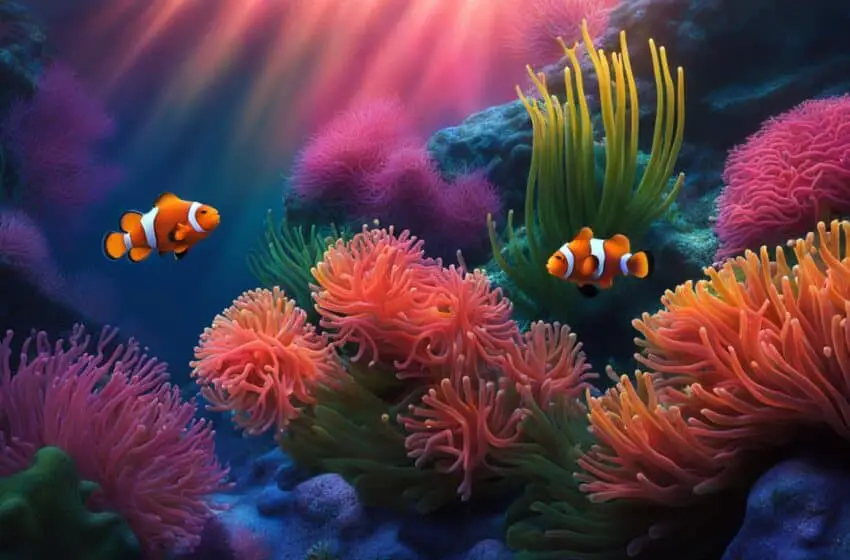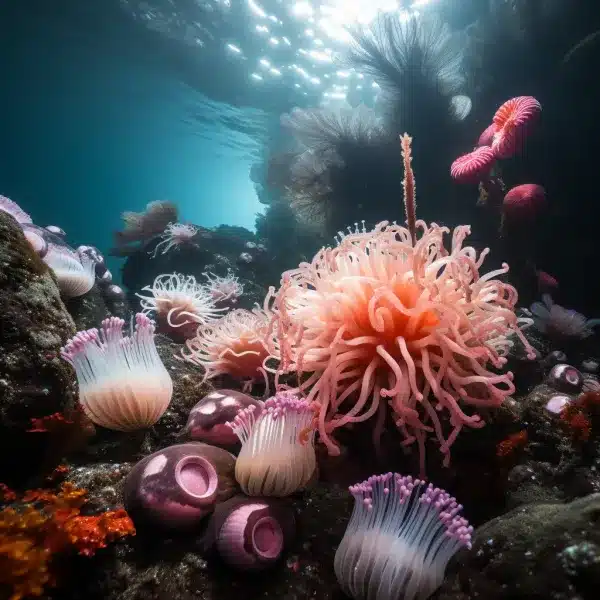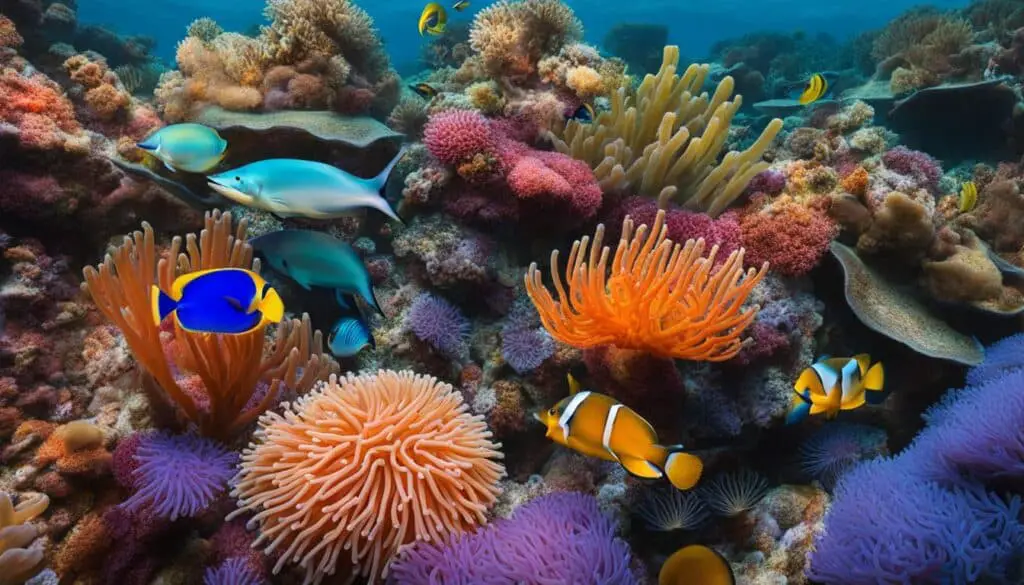Dive Into The Depths: Sea Anemones And Marine Biodiversity

Sea Anemones And Marine Biodiversity: Sea anemones and biodiversity are captivating subjects that offer a window into the intricate tapestry of life beneath the ocean’s surface. Join me on a virtual exploration as we delve into the mesmerizing world of sea anemones and their vital role in marine ecosystems.
The video from the H1993 dive of the NA153 expedition takes us on a mesmerizing journey near Johnston Atoll, where we encounter a plethora of unique marine life, from the Polychelidae slipper lobster to the elusive rattfish. This expedition, funded by NOAA Ocean Exploration, ventures into the deep-sea habitats beyond US national jurisdiction, offering a glimpse into the diverse and delicate ecosystems near the Pacific Remote Island Marine National Monument.
As we explore this underwater world, we’ll unravel the ecological importance of sea anemones and their symbiotic relationships. From providing essential habitats for other marine organisms to contributing to the resilience of coral reefs, sea anemones play a crucial role in marine biodiversity conservation.
Key Takeaways:
- Sea anemones are a fascinating part of marine life, contributing to biodiversity and ecosystem health.
- They form symbiotic relationships with other species, such as clownfish, which benefit both parties.
- Understanding the role and habitat requirements of sea anemones is essential for effective conservation efforts.
- These intricate ecological connections highlight the interconnectedness of marine ecosystems.
- Preserving the oceans and their delicate ecosystems is vital to safeguarding marine biodiversity for future generations.
The Role of Sea Anemones in Marine Biodiversity Conservation

Sea anemones are not only captivating to watch but also play a vital role in marine biodiversity conservation. With their diverse species and unique characteristics, sea anemones provide essential habitats for other marine organisms, contributing to the overall health and resilience of coral reefs and marine ecosystems. These fascinating creatures have a significant ecological importance that cannot be overlooked.
Sea anemones serve as homes and protection for various species, such as clownfish and shrimp, through their symbiotic relationships. The sea anemone’s tentacles provide shelter for these organisms, while the clownfish and shrimp offer food and help keep the anemone clean. This mutualistic relationship is an excellent example of the interconnectedness of marine life and the delicate balance that exists within ecosystems.
Understanding the specific habitat requirements of sea anemones is crucial for effective conservation efforts. Different sea anemone species have specific preferences for factors like water depth, temperature, and substrate type. By identifying and protecting these habitats, we can ensure the preservation of marine biodiversity and the continued existence of these remarkable creatures.
| Sea Anemone Species | Ecological Importance | Sea Anemone Habitat |
|---|---|---|
| Species A | Provides shelter and food for other marine organisms | Coral reefs |
| Species B | Contributes to the overall health and resilience of ecosystems | Rocky substrate |
| Species C | Supports biodiversity and maintains ecological balance | Sandy bottoms |
Conservation efforts aimed at protecting sea anemones and their habitats are crucial for the future of marine biodiversity. As we strive to understand and appreciate the ecological importance of these unique creatures, we can work towards ensuring their survival and the preservation of the delicate balance of marine ecosystems.
Symbiotic Relationships between Sea Anemones and Other Species
Sea anemones, with their mesmerizing beauty and graceful movements, form intricate symbiotic relationships with a wide range of species, playing a vital role in the balance of marine ecosystems. These relationships highlight the interdependence and interconnectedness of life beneath the ocean’s surface. Let’s explore some fascinating examples of symbiosis involving sea anemones:
Mutualistic Relationships: Clownfish and Sea Anemones
Sea anemone-clownfish mutualism is a famous marine mutualism. Anemone stinging cells defend clownfish from predators, and clownfish waste gives nutrition. This mutually beneficial cooperation helps both species survive in their habitat. These bright fish and delicate anemones make coral reefs vibrant, diverse ecosystems full with life.
Commensalistic Relationships: Barnacles and Humpback Whales
Commensalism is another type of symbiotic relationship observed in the marine world. An intriguing example of this can be seen between barnacles and humpback whales. Barnacles attach themselves to the whales’ skin and hitch a ride as the giants traverse the ocean. The transit and access to plankton-rich seas help barnacles, but not humpback whales. It is an example of how different species can coexist and mutually benefit from their interactions.
Parasitic Relationships: Barnacles and Swimming Crabs
In contrast to mutualistic and commensalistic relationships, some sea anemones form parasitic relationships with other species. Barnacles, for instance, act as parasites on swimming crabs, attaching themselves to the crab’s exoskeleton and siphoning off nutrients. This parasitic relationship exploits the crab’s resources and can have negative effects on its health and well-being. Parasitism serves as a reminder that not all symbiotic relationships are mutually beneficial.
These examples of symbiotic relationships between sea anemones and other species demonstrate the intricate web of connections in marine ecosystems. These symbiotic connections keep clownfish, sea anemones, barnacles, humpback whales, and swimming crabs in balance and biodiversity.

| Symbiotic Relationships | Examples |
|---|---|
| Mutualism | Clownfish and sea anemones |
| Commensalism | Barnacles and humpback whales |
| Parasitism | Barnacles and swimming crabs |
Conclusion
The study of sea anemones and their symbiotic relationships provides valuable insights into the intricate dynamics of marine biodiversity. Mutualistic, commensalistic, and parasitic connections help coral reefs and other marine ecosystems thrive.
However, the increasing environmental impact, including climate change, poses a threat to coral health and symbiotic interactions. Respect and protection of the oceans are essential to maintaining intricate symbiotic interactions and marine biodiversity for future generations.
Marine biodiversity is vital to ecosystems and human well-being. Coral reef and marine environment synbiosis sustains diverse life and provides food security, coastal protection, and tourism.
Thus, we must prioritize marine biodiversity protection and prevent environmental threats to coral health and symbiotic interactions. We can protect marine biodiversity and ocean health by supporting sustainable behaviors, decreasing pollution, and tackling climate change.
FAQ
What is the ecological importance of sea anemones?
Sea anemones play a crucial role in marine biodiversity conservation by providing essential habitats for other marine organisms and contributing to the overall health and resilience of coral reefs.
What are some examples of symbiotic relationships involving sea anemones?
Sea anemones form mutualistic relationships with clownfish, commensalistic relationships with barnacles and humpback whales, and parasitic relationships with barnacles and swimming crabs.
How do symbiotic relationships contribute to marine ecosystems?
Symbiotic relationships maintain the balance of marine ecosystems and promote biodiversity by providing protection, attracting prey, and benefiting from abundant food sources.
What are the potential threats to sea anemones and their symbiotic interactions?
Increasing environmental impacts, including climate change, pose a threat to coral health and symbiotic interactions, emphasizing the need to protect and preserve marine ecosystems.



